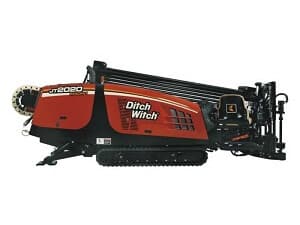How Much Does Ditch Witch Trencher Rental Cost?
Last Updated on February 21, 2024
Written by CPA Alec Pow | Content Reviewed by ![]() CFA Alexander Popinker
CFA Alexander Popinker
Trenchers are an essential piece of equipment for many construction and landscaping jobs. Ditch Witch is one of the leading brands when it comes to reliable and efficient trenching machinery.
If you have an upcoming project that requires trenching, you may be wondering what it costs to rent a Ditch Witch trencher and whether it’s better to rent or buy.
This guide will provide an overview of Ditch Witch trencher rental rates and factors that impact pricing. We’ll also offer tips to help you get the most value from your rental.
Trenchers are used for digging trenches to lay pipes, cables, drainage systems, foundations, and more. Renting a trencher allows you to get the equipment you need for the scope and duration of your specific project, rather than making an expensive purchase.
How Much Does Ditch Witch Trencher Rental Cost?
The minimum cost for Ditch Witch trencher rental starts from approximately $150 to $300 per day for small walk-behind trenchers, while the maximum cost can exceed $750 per day for large ride-on trenchers.
Prices vary depending on factors such as equipment size, rental duration, and specific model features.
Rental costs for Ditch Witch trenchers can range quite a bit based on the factors above, but these average rates help provide a general benchmark:
- Small walk-behind trenchers: Approximately $150 – $300 per day, $750 – $1,500 per week, or $2,000 – $4,000 per month. For example, you may pay around $250/day for a Ditch Witch C16X or $200/day for an RT20.
- Mid-size ride-on trenchers: Approximately $300 – $500 per day, $1,500 – $2,500 per week, or $4,000 – $8,000 per month. A Ditch Witch RT45 could average $375/day or an RT70 around $425/day.
- Large ride-on trenchers: Roughly $400 – $750+ per day, $2,000 – $3,750 per week, or $5,500 – $15,000+ per month. Expect to pay $550/day or more for models like the RT120 or RT175.
- Mini skid steers: Around $275 – $400 per day, $1,500 – $2,000 per week, or $3,500 – $5,000 per month. The SK500 may cost $325/day.
- Directional drills: Approximately $600 – $1,000 per day, $3,000 – $5,000 per week, or $7,500 – $12,500 per month. A JT20 could average $800/day.
These rates provide a general idea, but always confirm specific pricing with your rental provider, as costs can vary significantly depending on local availability. Prices also tend to increase during peak seasons in summer and early fall when demand is highest.
Acerentalsinc.com reports that the rental price for a 3ft walk-behind trencher is $195 per day, $585 per week, and $140 for four hours.
Types of Ditch Witch Trenchers Available for Rent
Ditch Witch offers a range of trencher models to suit different job requirements. The main types include:
- Walk-behind trenchers: Compact and highly maneuverable, ideal for smaller residential jobs. Examples include the Ditch Witch C16X, C24X, S3C, and RT45 models which can trench 4″ to 24″ wide and up to 7′ deep.
- Ride-on trenchers: More powerful and heavy-duty, best for long trenches in commercial projects. Models like the Ditch Witch RT70, RT120, and RT175 can trench 18″ to 36″ wide and up to 15′ deep.
- Mini skid steers: Offer additional versatility beyond trenching with attachments like augers, drills, and backhoes. Popular models are the Ditch Witch SK500 and SK800.
- Directional drills: Used to trench underneath structures and obstacles. The Ditch Witch JT20 is a compact, self-propelled model with 20,000 lbs. of thrust.
Choosing the right Ditch Witch model for your trenching needs will be the main factor impacting the rental cost. The larger and more heavy duty, the more expensive the rental rate.
Factors That Influence Rental Costs
Several important considerations affect how much it will cost to rent a Ditch Witch trencher:
- Model type and size: As mentioned, small walk-behind trenchers cost less per day than heavy ride-on models.
- Rental duration: Daily and weekly rates are more expensive than monthly rentals. Long-term rentals usually offer a discounted price.
- Location: Rental costs can vary by region and provider. Urban areas typically have higher rates.
- Additional equipment/services: Accessories like trencher attachments or dirt removal add to the base rate.
- Time of year: Prices increase during peak digging seasons in summer and early fall.
- Condition and age: Newer trenchers command higher rental fees than older, more worn models.
Taking the time to assess your specific project needs will ensure you select the right Ditch Witch model and rental terms to fit your budget. Avoid over or under-renting and account for all required accessories.
Benefits of Renting vs Buying
 Depending on your usage requirements, renting a Ditch Witch trencher is usually the most cost-effective option over purchasing. Benefits include:
Depending on your usage requirements, renting a Ditch Witch trencher is usually the most cost-effective option over purchasing. Benefits include:
- Lower upfront costs: Renting allows you to pay only for the time period you need rather than tens of thousands for a purchase.
- No maintenance or storage: The rental company handles maintenance, repairs, and storage between rentals.
- Latest equipment available: You can rent newer models with the latest features.
- Flexibility: Quickly adapt as job needs change instead of being locked into equipment that may be over or underpowered.
- No disposal required: Simply return the equipment when done rather than having to sell or dispose of a purchased trencher.
For most contractors or landscape companies that don’t require full-time trenching capabilities, renting makes the most financial sense.
You might also like our articles about the cost of backhoes, mini excavators, and trenching per foot.
Tips for Renting a Ditch Witch Trencher
Follow these tips to ensure you get optimal value from your Ditch Witch trencher rental:
- Take measurements and assess required trenching capacity to avoid under or over-renting. Factor in a buffer.
- Consider renting locally to avoid delivery fees if available.
- Ask about package discounts for renting multiple pieces of equipment.
- Inquire about short-term discounts for multi-day rentals to avoid daily fees.
- Avoid peak season rentals, if possible, when rates are highest.
- Ensure operators are trained and familiar with the specific model rented.
- Rent any necessary accessories like trencher attachments or safety gear.
- Discuss damage waivers and terms in case of any accidents.
Frequently Asked Questions
How long does it take to use a trencher?
The duration for completing a trenching job with a Ditch Witch walk-behind or ride-on trencher depends on several factors:
- Trench length and depth
- Soil conditions and terrain
- Trencher model power and size
- Operator experience and efficiency
On average, an experienced operator can trench at a rate of 100-400 linear feet per hour with a compact walk-behind trencher like the C16X or RT20. Ride-on trenchers with more power like the RT45 or RT70 may achieve 200-700+ linear feet per hour. Work duration estimates should account for soil conditions, obstructions, refueling, and potential delays.
How many feet per hour can a trencher trench?
A Ditch Witch trencher can typically trench between 100 and 700+ linear feet per hour, depending on the model and job conditions. Some general trenching rates for Ditch Witch models:
- Small walk-behind: 100-300 ft/hr. (up to 400 ft/hr. in ideal conditions)
- Mid-size ride-on: 200-500 ft/hr. (up to 600 ft/hr.)
- Large ride-on: 400-700+ ft/hr.
- Directional drill: Varies based on drilling distance
The trenching rate is heavily influenced by the soil, trench depth and width, obstacles, and operator skill. Loose, soft soil allows for maximum trenching speeds, while rocky ground slows progress.
How much does a Ditch Witch ride-on trencher weigh?
Ditch Witch ride-on trenchers are heavy pieces of machinery, with larger models weighing over 10,000 lbs. Some example weights:
- RT45: ~5,000 lbs.
- RT70: ~8,500 lbs.
- RT120: ~10,000 lbs.
- RT175: ~12,500 lbs.
The significant weight provides stability when trenching and gives these ride-on models the power to trench wider and deeper than walk-behind trenchers. The weight also means they may require trailers for transport.
How much fuel does a trencher use per hour?
Fuel consumption of a Ditch Witch trencher depends on the engine size but typically ranges from 1 to 5 gallons per hour.
Smaller walk-behind trenchers like the C16X use around 1-2 gallons per hour. Mid-size units like the RT70 can use 2-3 gallons per hour. Larger ride-on models with much higher horsepower may use 4-5 gallons per hour during heavy trenching.
Fuel usage also depends on the operating speed, soil conditions, and load on the trencher. Heavier trenching uses more fuel. Checking the operator’s manual provides typical per hour fuel consumption.


Leave a Reply
Want to join the discussion?Feel free to contribute!